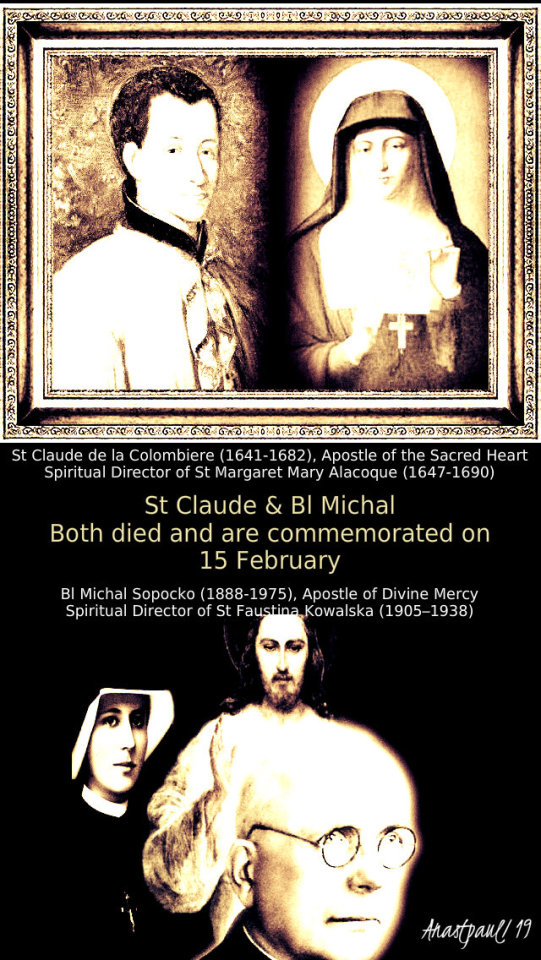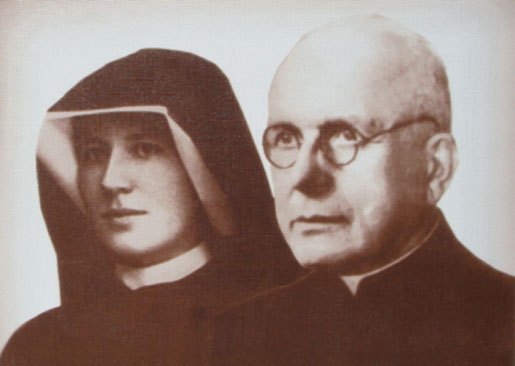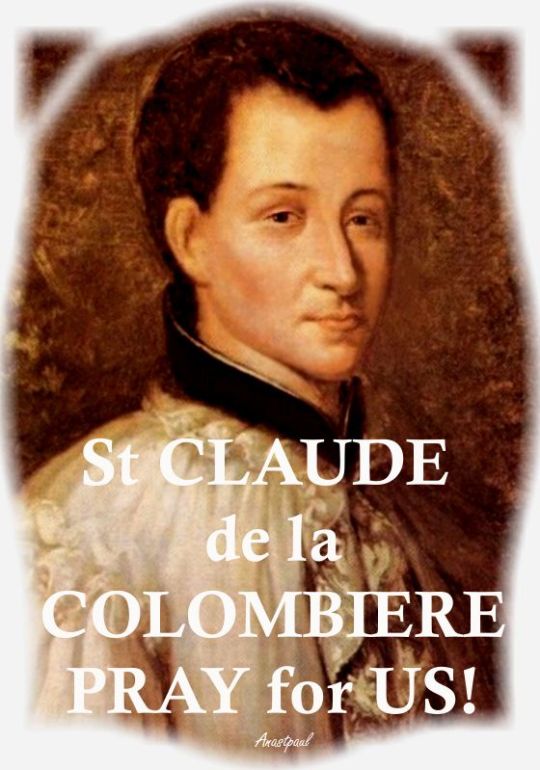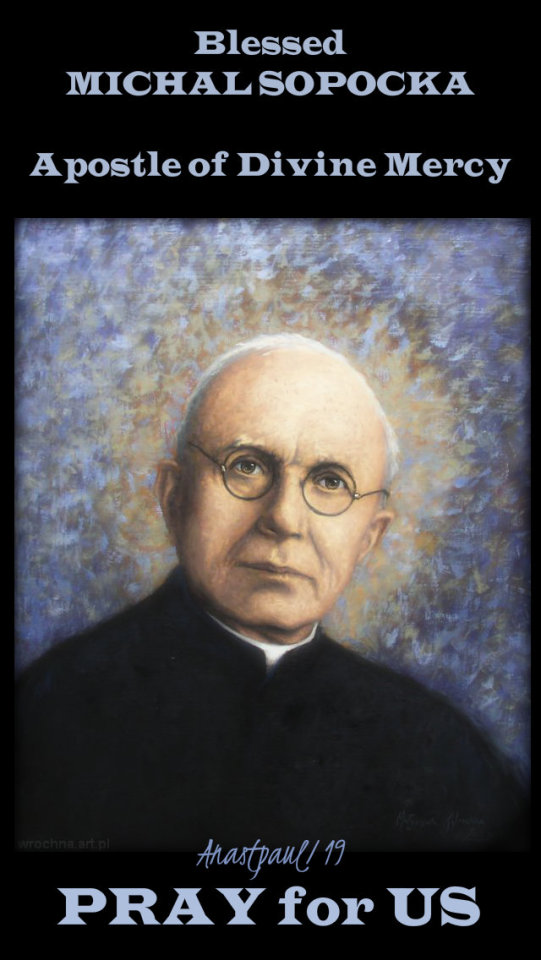#february15stclaudedelacolombiere
Explore tagged Tumblr posts
Photo

Thought for the Day – 15 February – the Memorial of St Claude de la Colombiere (1641-1682) Apostle of the Sacred Heart and Blessed Michal Sopoćko (1888-1975) Apostle of Divine Mercy
Saint Claude de la Colombiere and Blessed Michael Sopoćko share a few things in common
We celebrate the feast day of Blessed Michael Sopoko today, 15 February, which makes for a perfect opportunity to discuss one of the more curious details in the life of St Faustina Kowalska (1905–1938), known today as the Lord’s “secretary” of Divine Mercy.
So what’s so curious?
Amazing parallels can be drawn between St Faustina’s confessor, Blessed Sopoćko and the confessor of another saint — and “secretary” — St. Margaret Mary Alacoque (1647-1690), who received the revelations of the Sacred Heart in the 1670s.
In other words, the similarities between the holy priests Blessed Michael Sopoćko (1888-1975) and St Claude de la Colombiere, SJ (1641-1682), both of whom died today and, therefore, we celebrate their entry into life today.
Blessed Sopoćko , ordained to the priesthood over 100 years ago, served as confessor and spiritual director to St Faustina Kowalska, who received revelations of the Divine Mercy in the 1930s. Saint Claude served as confessor and spiritual director of St Margaret Mary Alacoque, who received the revelations of the Sacred Heart in the 1670s.
So here is where the parallels begin. Saint Margaret Mary Alacoque, like St Faustina, had doubts at first about her revelations. For both young women, it was their confessors who played a large role in alleviating their doubts and encouraging them to embrace the special role the Lord seemed to be placing upon them.
But the parallels get even better. Since St Margaret Mary Alacoque led a cloistered life — quiet and humble — it was her confessor who carried the burden of spreading the Sacred Heart message and devotion to the outside world. This was the same situation with Fr Sopocko, who led the efforts to introduce the public to Faustina’s powerful private revelations and who arranged for the Lord’s requests of Faustina to be accomplished. That includes hiring a painter to paint the image of the Merciful Saviour, now among Christianity’s most recognised images.
Here’s another interesting fact:
Saint Claude Colombiere died today, 15 February, the same day Blessed Sopoćko died. And 15 February, also happens to be St Faustina’s name day — the day of her patron saint, St Faustus.
Of course, when considering how the devotions to Divine Mercy and the Sacred Heart so strongly compliment each other, these details are far more than “curious.” Certainly, they are Divine Providence at work, right?

Dr Robert Stackpole, STD, director of the St John Paul II Institute of Divine Mercy, a lay apostolate of the Marian Fathers of the Immaculate Conception, notes, “Much like the traditional devotion to the Sacred Heart, our Lord gave to St. Faustina new forms in which His Merciful Heart was to be honoured and new vessels for a fresh outpouring of His grace. Namely, the Image of Divine Mercy; the Chaplet of Divine Mercy and, of course, a new feast for the universal Church — the Feast of Divine Mercy, intended for the Sunday after Easter.”
None of these parallels have escaped the attention of Fr Seraphim Michalenko, MIC, a world-renown expert on the life of St Faustina and the message of Divine Mercy.
He notes that it took 300 years for Fr Claude Colombiere to be canonised. “And here, Fr Sopoćko died in 1975 and he’s already beatified [in 2008],” Fr Seraphim says.
So what does his rapid rise to the honours of the altar, mean for us?
“That God is in a hurry to get His message out,” says Fr Seraphim

Adapted from the Library Archive of The Divine Mercy – (Felix Carroll Feb 13, 2014)

St Claude de la Colombiere, Pray for Us!

Blessed Michal Sopoćko, Pray for Us!
(via Thought for the Day - 15 February - Saint Claude de la Colombiere and Blessed Michael Sopoćko share a few things in common)
#thoughtforthedayfebruary15#february15blmichalsopocka#mypics#february15stclaudedelacolombiere#mypic#catholic#catholicism
7 notes
·
View notes
Photo


Saint of the Day – 15 February – St Claude de la Colombiere S.J. (1641-1682) Religious Priest, Confessor, Patron of the Sacred Heart of Jesus, Ascetical Writer, Teacher, Preacher, Missionary. Patronages – Devotion to the Sacred Heart, toy-makers, turners. St Claude was a Jesuit priest and the confessor of St Margaret Mary Alacoque, the visionary of the Sacred Heart of Jesus. St Claude was born on 2 February 1641 at Saint-Symphorien d’Ozon, Rhône, France and he died on 15 February 1682 at Paray-le-Monial, Saône-et-Loire, France of hemoptysis (coughing up blood). He was Canonised on 31 May 1992 by St Pope John Paul II in Rome, Italy.

CLAUDE DE LA COLOMBIÈRE, third child of the notary Bertrand de la Colombière and Margaret Coindat, was born on 2nd February 1641 at St Symphorien d’Ozon in the Dauphine, southeastern France. After the family moved to Vienne, Claude began his early education there, completing his studies in rhetoric and philosophy in Lyon.
It was during this period that Claude first sensed his vocation to the religious life in the Society of Jesus. We know nothing of the motives which led to this decision. We do know, however, from one of his early notations, that he “had a terrible aversion for the life embraced”. This affirmation is not hard to understand by any who are familiar with the life of Claude, for he was very close to his family and friends and much inclined to the arts and literature and an active social life. On the other hand, he was not a person to be led primarily by his sentiments. At 17 he entered the Jesuit Novitiate at Avignon. In 1660 he moved from the Novitiate to the College, also in Avignon, where he pronounced his first vows and completed his studies in philosophy. Afterwards he was professor of grammar and literature in the same school for another five years.
In 1666 he went to the College of Clermont in Paris for his studies in theology. Already noted for his tact, poise and dedication to the humanities, Claude was assigned by superiors in Paris the additional responsibility of tutoring the children of Louis XIV’s Munster of Finance, Jean Baptiste Colbert. His theological studies concluded and now a priest, Claude returned to Lyon. For a time he was teacher in the College, then full-time preacher and moderator of several Marian congregations.


Claude became noted for solid and serious sermons. They were ably directed at specific audiences and, faithful to their inspiration from the gospel, communicated to his listeners serenity and confidence in God. His published sermons produced and still produce significant spiritual fruits. Given the place and the short duration of his ministry, his sermons are surprisingly fresh in comparison with those of better-known orators.
The year 1674 was a decisive one for Claude, the year of his Third Probation at Maison Saint-Joseph in Lyon. During the customary month of the Exercises the Lord prepared him for the mission for which he had been chosen. His spiritual notes from this period allow one to follow step-by-step the battles and triumphs of the spirit, so extraordinarily attracted to everything human, yet so generous with God.
He took a vow to observe all the constitutions and rules of the Society of Jesus, a vow whose scope was not so much to bind him to a series of minute observances as to reproduce the sharp ideal of an apostle so richly described by St Ignatius. So magnificent did this ideal seem to Claude that he adopted it as his program of sanctity. That it was indeed an invitation from Christ himself is evidenced by the subsequent feeling of interior liberation Claude experienced, along with the broadened horizons of the apostolate he witnesses to in his spiritual diary.
On 2nd February 1675 he pronounced his solemn profession and was named rector of the College at Paray-le-Monial. Not a few people wondered at this assignment of a talented young Jesuit to such an out-of the-way place as Paray. The explanation seems to be in the superiors’ knowledge that there was in Paray an unpretentious religious of the Monastery of the Visitation, Margaret Mary Alacoque, to whom the Lord was revealing the treasures of his Heart but who was overcome by anguish and uncertainty. She was waiting for the Lord to fulfil his promise and send her “my faithful servant and perfect friend” to help her realise the mission for which he had destined her: that of revealing to the world the unfathomable riches of his love.

After Father Colombière’s arrival and her first conversations with him, Margaret Mary opened her spirit to him and told him of the many communications she believed she had received from the Lord. He assured her he accepted their authenticity and urged her to put in writing everything in their regard and did all he could to orient and support her in carrying out the mission received. When, thanks to prayer and discernment, he became convinced that Christ wanted the spread of the devotion to his Heart, it is clear from Claude’s spiritual notes that he pledged himself to this cause without reserve. In these notes it is also clear that, even before he became Margaret Mary’s confessor, Claude’s fidelity to the directives of St Ignatius in the Exercises had brought him to the contemplation of the Heart of Christ as symbol of His love.
After a year and half in Paray, in 1676 Father La Colombière left for London. He had been appointed preacher to the Duchess of York – a very difficult and delicate assignment because of the conditions prevailing in England at the time. He took up residence in St James Palace in October. In addition to sermons in the palace chapel and unremitting spiritual direction both oral and written, Claude dedicated his time to giving thorough instruction to the many who sought reconciliation with the Church they had abandoned. And even if there were great dangers, he had the consolation of seeing many reconciled to it, so that after a year he said: “I could write a book about the mercy of God I’ve seen Him exercise since I arrived here!”
The intense pace of his work and the poor climate combined to undermine his health, and evidence of a serious pulmonary disease began to appear. Claude, however, made no changes in his work or life style. Of a sudden, at the end of 1678, he was calumniously accused and arrested in connection with the Titus Oates “papist plot”. After two days he was transferred to the severe King’s Bench Prison where he remained for three weeks in extremely poor conditions until his expulsion from England by royal decree. This suffering further weakened Claude’s health which, with ups and downs, deteriorated rapidly on his return to France.

During the summer of 1681 he returned to Paray, in very poor condition. On 15th February 1682, the first Sunday of Lent, towards evening Claude suffered the severe haemorrhage which ended his life.

On the 16th of June 1929 Pope Pius XI beatified Claude de la Colombière, whose charism, according to St Margaret Mary Alacoque, was that of bringing souls to God along the gospel way of love and mercy which Christ revealed to us. (vatican.va)

It is said that the day after Claude’s death, Sister Margaret Mary received supernatural assurance that Claude needed no prayers, as he was in already heaven; he was enjoying the fullness of communio with the Trinity. Claude was considered a “dry” martyr, having suffered every abuse for the Christian faith except death. The life of Saint Claude was an example of being in correspondence with the Lord Himself –through the logic of Love– that he was known to be concrete example of mercy in the face of trials. Saint Claude’s life of holiness drew many of the Protestants to the Catholic Church. His was a trust that we must adopt: “In Thee, O Lord, have I hoped; let me never be confounded.”
May we learn from Saint Claude la Colombiere what it means to be in relationship with Jesus the Good Shepherd, true Divine Love.

Mosaic of the Sacred Heart of Jesus, St Claude la Colombiere Chapel, Paray-le-Monial
(via AnaStpaul – Breathing Catholic)
28 notes
·
View notes
Photo

Blessed Memorial of St Claude de la Colombiere S.J. (1641-1682) - 15 February
All our life is sown with tiny thorns that produce in our hearts a thousand involuntary movements of hatred, envy, fear, impatience, a thousand little fleeting disappointments, a thousand slight worries, a thousand disturbances that momentarily alter our peace of soul. For example, a word escapes that should not have been spoken. Or someone utters another that offends us. A child inconveniences you. A bore stops you. You don’t like the weather. Your work is not going according to plan. A piece of furniture is broken. A dress is torn. I know that these are not occasions for practicing very heroic virtue. But they would definitely be enough to acquire it if we really wished to. —Claude la Colombiére
St. Claude la Colombiére was one of the most effective preachers of the 17th century. Against this heretical view that humans could not obey God without the intervention of overpowering grace, he celebrated our freedom to choose submission. Calmly accepting even the tiniest vexations, as he argued above, could be chances to surrender to God.

At 17, Claude said, he overcame a temporary revulsion against religious life and joined the Jesuits at Avignon. His earliest assignments included teaching boys grammar and tutoring the sons of J. B. Colbert, finance minister to King Louis XIV. When he turned 33, Claude made his profession as a Jesuit. Reflecting on the significance of Christ’s 33rd year, he decided he must die more completely to himself. Thus he made a promise to follow exactly the Jesuit rule and to obey his superiors without question. “It seems right, dear Lord,” he wrote, “that I should live in you and for you alone, at the age when you died for all and for me in particular.”
The next year he was made head of the Jesuit college at Paray-le-Monial, where he met St. Margaret Mary Alacoque. As her spiritual director, (and she received confirmation in her heart that he was the one the Lord had sent her) he assured her of the authenticity of her revelations about the Sacred Heart. His writings provided a sound theological basis for the devotion and his preaching helped spread it.
Upon meeting her, Saint Claude immediately recognized her humble sanctity and acknowledged the truth of her claims. She told him of her communications with the Lord, which he encouraged her to write down in detail. Convinced through prayer and meditation that it was the will of God for others to hear of these communications, he later compiled these visions into a book and devoted himself to spreading the message of God’s love.
“The love of Our Lord’s Heart was in no way diminished by the treason of Judas, the flight of the apostles, and the persecution of his enemies. Jesus was only grieved at the harm they did themselves; His sufferings helped to assuage His grief because He saw in tham a remedy for the sins committed by His enemies. The Sacred Heart was full of most tender love; there was no bitterness in it; no cruelty and injustice that He received moved it to feelings other than those of compassion and affection.”



In 1676, because of his reputation for holiness and oratory, Claude was sent to London as preacher to Mary Beatrice d’Este, duchess of York. He became well-known not only for his finely-tuned sermons but also for encouraging persecuted Catholics, restoring lapsed Catholics and converting Protestants. Saint Claude continued his good work in England until 1678 when he, along with many priests and religious, were accused of involvement in a “Papist Plot” to assassinate and wrest power from King Charles II. Saint Claude was thrown into prison, where he languished in horrible conditions, until the intervention of the Duchess of York and King Louis XIV. He was released and returned to France but his imprisonment had taken a serious toll on his health. He rapidly deteriorated and died on the first Sunday of Lent in 1682. He is considered a “dry martyr,” having long-suffered for the Lord.
When the news reached the Visitation monastery on the following morning, Saint Margaret Mary immediately urged her community: “Pray for him and get everyone else to pray for him.” However, at sometime around eleven that morning, she stopped praying, smiling and declared: “Stop worrying about him. Invoke him; have no fear, he is more powerful than ever to help you.” The prioress of the order, Mother M. Greyfie, gently inquired as to why she had felt the urge to stop praying. Generally, Margaret Mary would ask for prayers or mortifications when someone died. Saint Margaret Mary replied with an expression of great joy: “Father La Colombière has no further need of them. He is now in a position to pray for us, so well placed is he in heaven by the goodness and mercy of the Sacred Heart of Our Lord.”
Devotion of the Sacred Heart of Jesus only grew. Saint Margaret Mary continued to seek the intercession of Saint Claude for the next eight years, until she died, praying, “O Blessed Father Claude la Colombiere, I take you for my intercessor before the Sacred Heart of Jesus Christ. Obtain for me from His goodness the grace not to resist the designs He has on my soul and to make me a more perfect imitator of the virtues of His Divine Heart.”





7 notes
·
View notes
Video
youtube
Saint of the Day – 15 February – St Claude de la Colombiere S.J. (1641-1682) – Religious, priest, confessor, missionary, writer, spiritual director “Disciple of the Sacred Heart” – Patron of toy-makers, turners and devotion to the Sacred Heart of Jesus
2 notes
·
View notes
Photo

Thought for the Day – 15 February – The Memorial of St Claude de la Colombiere S.J. (1641-1682)
This is a special day for the Jesuits, who claim today’s saint as one of their own. It’s also a special day for people who have a special devotion to the Sacred Heart of Jesus—a devotion Claude de la Colombière promoted, along with his friend and spiritual companion, St Margaret Mary Alacoque. The emphasis on God’s love for all was an antidote to the rigorous moralism of the Jansenists, who were popular at the time.
Claude showed remarkable preaching skills long before his ordination in 1675. Two months later, he was made superior of a small Jesuit residence in Burgundy. It was there he first encountered Margaret Mary Alacoque. For many years after he served as her confessor.
As a fellow Jesuit and as a promoter of the devotion to the Sacred Heart of Jesus, Saint Claude must be very special to Pope Francis who has so beautifully emphasised the mercy of Jesus. The emphasis on God’s love and mercy are characteristic of both men.
“The past three centuries allow us to evalutate the importance of the message which was entrusted to Claude. In a period of contrasts between the fervour of some and the indifference or impiety of many, here is a devotion centred on the humility of Christ, on His presence, on His love of mercy and on forgiveness. Devotion to the Heart of Christ would be a source of balance and spiritual strengthening for Christian communities so often faced with increasing unbelief over the coming centuries. May the canonisation of Claude La Colombiere be for the whole Church an appeal to live the consecration to the Heart of Christ, a consecration which is a self-giving that allows the charity and mercy of Christ to inspire us, pardon us and lead us in His ardent desire to open the ways of truth and life to all our brothers and sisters!”…St Pope John Paul II, during the canonisation of Saint Claude (31 May 1992)
St Claude de la Colombiere, pray for us!
(via AnaStpaul – Breathing Catholic)
#mypic#thoughtforthedayfebruary15#february15stclaudedelacolombiere#jesuit#stpopejohnpaul#catholic#catholicism
1 note
·
View note
Photo

One Minute Reflection – 15 February – The Memorial of St Claude de la Colombiere S.J. (1641-1682)
Blessed be the God and Father of our Lord Jesus Christ, who in his great mercy gave us a new birth to a living hope through the resurrection of Jesus Christ from the dead, to an inheritance that is imperishable, undefiled and unfading, kept in heaven for you...1 Peter 1:3-4

REFLECTION – “Lord, I am in this world to show Your mercy to others. Other people will glorify You, by making visible the power of Your grace, by their fidelity and constancy to You. For my part I will glorify You, by making known how good You are to sinners, that Your mercy is boundless and that no sinner, no matter how great his offences, should have reason to despair of pardon. If I have grievously offended You, My Redeemer, let me not offend You even more, by thinking that You are not kind enough to pardon me.” … St Claude de la Colombiere

PRAYER – Heavenly Father, Your great mercy, gave us Your Son! Surely nothing can be a greater proof to us of Your unending love and mercy to Your lowly creatures, we who are dust. Through Him, who died and rose for us, You have shown us the way of true mercy. Grant us this day that by the intercession of St Claude, we may take up our crosses with Him, never leaving the love of His Sacred Heart, so that we may join Your holy saints in eternal life. Through Your Son, our Lord Jesus Christ, in union with the Holy Spirit, one God forever, amen.
(via AnaStpaul – Breathing Catholic)
#mypics#mypic#oneminutereflectionfebruary15#february15stclaudedelacolombiere#1peter1:3-4#catholic#catholicism#stclaudedelacolombiere#jesuit
2 notes
·
View notes
Video
youtube
Blessed Memorial of St Claude de la Colombière - 15 February
2 notes
·
View notes